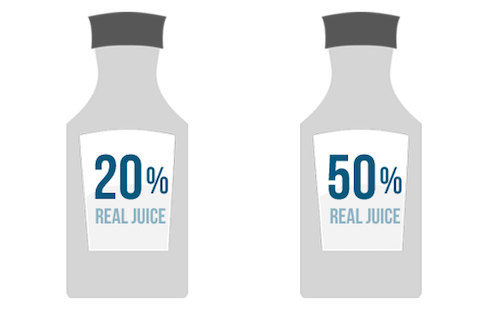
What Are PSAT Percentiles?
Once you get your scores back, you'll see the different values described above - your raw scores, your section scores, and your scaled scores. Additionally, your score report will tell you your percentiles.
Your score report will tell you two percentiles: the Nationally Representative Sample percentile and the User Percentile. Your Nationally Representative Sample percentile may look higher, since it confusingly includes projections for all students in a grade, even those who typically don't the PSAT.
It seems that your User percentile will be the most reliable piece of data, since it only includes students who are actually very likely to take the PSAT. Therefore, the chart below gives you User percentiles, or for how your PSAT scores compare to other students in your grade who took the test.
So how do percentiles work? They simply tell you the percentage of students compared to which you scored higher or the same. If your scaled scores land in the 80th percentile, for example, then you scored the same as or higher than 80% of other test-takers. The other 20% scored higher than you.
Students' performance varies on Math, Reading, and Writing, so a score of 600 on Math, for example, may translate to a different percentile than the same score on Reading and Writing. Read on to see how scores from the new PSAT are expected to convert to User Percentiles.
What PSAT Scores Will Rank in a High Percentile?
This chart has the full list converting PSAT/NMSQT scaled scores to percentiles. This information is sourced from College Board's data on the PSAT administered in October 2015.
As you read through the chart, notice that you don't have to have a perfect scaled score to make it into the top 99%. This is important if you're aiming for National Merit - you don't have to get a perfect score to make it into the top 1%.
| Score | Reading and Writing | Math |
| 760 | 99+ | 99+ |
| 750 | 99+ | 99+ |
| 740 | 99+ | 99 |
| 730 | 99+ | 98 |
| 720 | 99 | 98 |
| 710 | 99 | 97 |
| 700 | 99 | 97 |
| 690 | 98 | 96 |
| 680 | 98 | 96 |
| 670 | 97 | 95 |
| 660 | 96 | 94 |
| 650 | 95 | 93 |
| 640 | 94 | 93 |
| 630 | 92 | 92 |
| 620 | 91 | 90 |
| 610 | 89 | 89 |
| 600 | 86 | 88 |
| 590 | 84 | 86 |
| 580 | 82 | 83 |
| 570 | 79 | 80 |
| 560 | 77 | 78 |
| 550 | 74 | 74 |
| 540 | 71 | 70 |
| 530 | 67 | 66 |
| 520 | 63 | 61 |
| 510 | 59 | 59 |
| 500 | 54 | 55 |
| 490 | 50 | 50 |
| 480 | 47 | 45 |
| 470 | 43 | 39 |
| 460 | 39 | 36 |
| 450 | 35 | 33 |
| 440 | 32 | 27 |
| 430 | 28 | 23 |
| 420 | 25 | 19 |
| 410 | 23 | 16 |
| 400 | 21 | 14 |
| 390 | 18 | 11 |
| 380 | 15 | 8 |
| 370 | 11 | 6 |
| 360 | 9 | 5 |
| 350 | 7 | 4 |
| 340 | 5 | 3 |
| 330 | 4 | 1 |
| 320 | 2 | 1 |
| 310 | 1 | 1 |
| 300 | 1 | 1 |
| 290 | 1- | 1 |
| 280 | 1- | 1 |
| 270 | 1- | 1 |
| 260 | 1- | 1 |
| 250 | 1- | 1 |
| 240 | 1- | 1 |
| 230 | 1- | 1- |
| 220 | 1- | 1- |
| 210 | 1- | 1- |
| 200 | 1- | 1- |
| 190 | 1- | 1- |
| 180 | 1- | 1- |
| 170 | 1- | 1- |
| 160 | 1- | 1- |
This conversion might vary a bit each year, and College Board's data on the new PSAT is still preliminary and subject to change. In previous years, the Math section was slightly more competitive than Reading and Writing. Similarly, math gets noticeably more competitive as you look at the lowest scores, and you would need 30 to 40 points higher in Math than in Reading and Writing to score in the 99th percentile.
For the most part, though, both sections look like the same scores convert to more or less the same percentiles. At a few levels, Reading and Writing looks to be even more competitive than Math. Let's take a closer look at these percentiles to try to answer our original question of what makes a good score on the PSAT.

The higher percentage, the better.
What's a Good PSAT Score Based on Percentiles?
Based on the chart above, an average PSAT score, or one that's right in the middle in the 50th percentile, is about 490 for both Reading and Writing and for Math. We can define good as being not just above average, but also as stronger than a significant majority of other test-takers.
Given that definition, these are approximately the scaled scores you need in each section to score in the 70th, 80th, 90th, and 99th percentiles.
| Percentile | Reading and Writing Score | Math Score | Composite Score |
| 70% | 540 | 540 | 1080 |
| 80% | 580 | 570 | 1150 |
| 90% | 620 | 620 | 1240 |
| 99% | 700 | 740 | 1440 |
As you can see, both sections convert to roughly the same percentiles except when you approach the 99th percentile. Then you'd need to score about 40 points higher in Math to make it into the top 1%.
Apart from scoring higher than other students, you might define a good score as one that qualifies for National Merit. Let's take a look at what you need to qualify.

The original National Merit Scholar.
What's a Good PSAT Score for National Merit?
The percentiles in the chart above compare students all across the U.S who typically take the PSAT. To determine whether you qualify for National Merit, though, you actually have to look at how your scores compare to those of other students in your state.
The National Merit Scholarship Corporation (NMSC) compares scores on a state to state basis. It names the top 3 to 4% of students Commended Scholar. To be named a National Merit Semifinalist, you have to score at the very top. National Merit Semifinalist distinction is given to the top 1%.
The important thing to remember about National Merit is that it uses its own Selection Index. Since the PSAT changed its scoring system this year, this new Selection Index differs from that used in previous years. Before scrolling down to the chart below, read this next section to make sure you understand the PSAT Selection Index of today.
Important: NMSC's New Selection Index
National Merit has always used its own Selection Index, or scoring scale, to determine Commended Scholars and Semifinalists. In past years, this Selection Index looked a lot like PSAT scaled scores, so you may not have noticed. This year, though, it looks quite a bit different, even though it’s calculated in a similar way.
As you read above, the PSAT lumps together the Reading and Writing sections in one final scaled score. National Merit, however, still wants to consider these two sections, Reading and Writing, separately. Therefore, NMSC looks at your section scores rather than at your scaled score. It takes your Math section score, Reading section score, and Writing section score - all of which fall between 8 and 38 - adds them together, and then multiplies by 2.
The NMSC Selection Index has a scale between 48 and 228. Confused yet? Let's look at an example.
The Breakdown: NMSC’s New Selection Index
Where does NMSC get this scale of 48 to 228? Let’s say you got minimum scores of 8 on each of the three PSAT sections. You could figure out your Selection Index by adding 8 + 8 + 8 (= 24) and then multiplying by 2 (= 48). That’s the lowest end of the Selection Index scale.
What about the max Selection Index score of 228? You could get that with top section scores of 38 in all three sections. 38 + 38 + 38 = 114. Multiply that by 2, and you get 228. Now you can see that the Selection Index isn’t as random as it might have looked at first glance - it just relies on your PSAT section scores between 8 and 38, rather than your PSAT scaled scores between 160 and 760. You can also see why we took the time to go over all these terms at the beginning of the article!
Based on reported data from individuals around the country, we've put together a list of every Selection Index cutoff across the United States for the PSAT in 2015. If you see any error with your state, let us know in the comments! Here are the qualifying scores from the old PSAT (2014 and earlier) and the new PSAT (2015 and later).
| State | Old PSAT Cutoff | New PSAT Cutoff |
| Alabama | 207 | 215 |
| Alaska | 210 | 213 |
| Arizona | 213 | 219 |
| Arkansas | 206 | 213 |
| California | 222 | 221 |
| Colorado | 213 | 218 |
| Connecticut | 220 | 220 |
| Delaware | 215 | 218 |
| District of Columbia | 224 | 222 |
| Florida | 211 | 217 |
| Georgia | 215 | 219 |
| Hawaii | 214 | 217 |
| Idaho | 211 | 214 |
| Illinois | 215 | 219 |
| Indiana | 212 | 217 |
| Iowa | 207 | 215 |
| Kansas | 213 | 217 |
| Kentucky | 210 | 215 |
| Louisiana | 208 | 214 |
| Maine | 212 | 214 |
| Maryland | 221 | 221 |
| Massachusetts | 223 | 222 |
| Michigan | 210 | 216 |
| Minnesota | 215 | 219 |
| Mississippi | 207 | 212 |
| Missouri | 209 | 216 |
| Montana | 206 | 210 |
| Nebraska | 209 | 215 |
| Nevada | 208 | 214 |
| New Hampshire | 212 | 216 |
| New Jersey | 224 | 222 |
| New Mexico | 210 | 213 |
| New York | 218 | 219 |
| North Carolina | 212 | 218 |
| North Dakota | 201 | 209 |
| Ohio | 213 | 217 |
| Oklahoma | 206 | 213 |
| Oregon | 217 | 219 |
| Pennsylvania | 216 | 218 |
| Rhode Island | 212 | 217 |
| South Carolina | 209 | 215 |
| South Dakota | 203 | 209 |
| Tennessee | 212 | 218 |
| Texas | 218 | 220 |
| Utah | 208 | 215 |
| Vermont | 213 | 215 |
| Virginia | 219 | 221 |
| Washington | 219 | 220 |
| West Virginia | 201 | 209 |
| Wisconsin | 208 | 215 |
| Wyoming | 204 | 209 |
| Average | 212 | 216 |
As you can see, New Jersey, DC, and Massachusetts require some of the highest scores to qualify. The average qualifying scores for all states is a little lower at around 216.
If you haven't taken the PSAT yet and are serious about achieving excellent scores, then I'd recommend aiming for at least 2 to 5 points higher than these cutoffs, as the actual qualifying scores can vary from year to year.
How can you figure out your target section scores? By understanding where the new Selection Index comes from, you can take our estimate for your state and simply work backwards. Let’s consider a few examples.
How to Calculate Your Target Scores for National Merit
As you read above, National Merit will take each of your section scores between 8 and 38, add them together, and multiply by 2. To figure out your target scores by section, take these steps and go through them in reverse.
First, divide your state’s cutoff qualifying score by 2. Let’s say you live in New Jersey, and your cutoff will be an estimated 222. Divide that in half and you get 111 (222 / 2 = 111).
Now, your section scores in Math, Reading, and Writing should add up to 111. Divide 111 by 3 and you’re looking at a 37 in each section: 111 / 3 = 37. You could define your target scores as about 37 in each section - or a little higher to be safe.
If you’re more confident in Math, then you could aim for a top math section score of 38. Then you’d have slightly more wiggle room in Reading and Writing. Depending on your strengths and weaknesses, you can set your target scores in the optimal way.
To review, you can define your target section scores by dividing your state’s cutoff in half. Then divide by 3 to get a sense of what you need in each section of the PSAT. Customize your target section scores from there.
Of course, only a small number of students are actually aiming to score in the top 1%. You may very well be deciding what's a good PSAT score based on your own goals for the test, as well as for the SAT and ultimately, college.

Pause for your quintessential collegiate building.
What's a Good PSAT Score for Your College Plans?
Even if you're not competing for National Merit, the PSAT still matters and is an important test along the path to college. It's valuable practice for the SAT and can help predict your SAT scores. The redesigned exams are very similar, with matching content and format and comparable scoring systems.
By doing some research into the colleges you're interested in, you can figure out what you need to score on the SAT. Simply Google the name of your school, along with "average SAT scores." Most schools release data on the average SAT scores of accepted students, so you have a sense of what you need to be a competitive candidate.
Then you can use your PSAT scores to determine where you're currently scoring and how much more you need to improve. Based on your target scores and time you can commit to prep, you can design a schedule to prep and raise your scores.
The following is a rough estimate of how many hours you need to devote to studying to achieve certain score improvements on the PSAT.
- 0-50 SAT composite point improvement: 10 hours
- 50-100 point improvement: 20 hours
- 100-200 point improvement: 40 hours
- 200-300 point improvement: 80 hours
- 300-500 point improvement: 150 hours+
Whether or not you've already taken the SAT, your PSAT score is a useful starting point to measure your level and figure out where you need to go from there. Then you can make a study schedule to get yourself where you want to be.
Finally, these are the most important points to remember when you take the PSAT and determine whether or not you're satisfied with your scores.

Key Points to Remember
If you took the PSAT in October 2015, you were kind of a College Board guinea pig. 2015 was the first year featuring the redesigned PSAT with a new scoring scale and Selection Index. Remember that the PSAT is now scored between 320 and 1520, which is a composite of the Math section and the Reading and Writing sections together.
To score in the 70th percentile or above, you want to aim for at least a 540 in Reading and Writing and a 540 in Math (or a composite of 1080). To qualify for National Merit, you'll need something like an impressive Selection Index score of 214, or a section score around 35 to 36 in Math, Reading, and Writing.
The PSAT is a valuable benchmark that you can use to plan your studying for the SAT. Make sure to check your PSAT scores right away to see if you need to take any further steps, like for National Merit, and to move forward with your SAT prep.
What's Next?
For more on the changes that were made to the PSAT in 2015, check out our complete PSAT guide. Then head on over to these free PSAT practice tests and other resources to prepare for the exam.
Are you wondering what makes a good SAT score? This article breaks down the percentiles so you can see what exactly counts as a bad, good, and excellent score on the SAT.
Besides the PSAT/NMSQT that qualifies for National Merit when you take it as a junior, College Board now also offers the PSAT to 8th, 9th, and 10th graders to prepare. Learn about the PSAT 8/9 and the PSAT 10 and how to decide between these tests and the regular PSAT.













